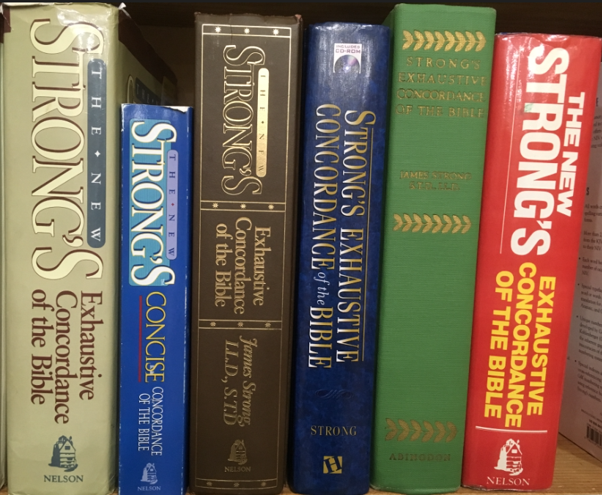Strong's Concordance on:
[Wikipedia]
[Google]
[Amazon]
 ''The Exhaustive Concordance of the Bible'', generally known as Strong's Concordance, is a Bible concordance, an index of every word in the
''The Exhaustive Concordance of the Bible'', generally known as Strong's Concordance, is a Bible concordance, an index of every word in the 
 ''The Exhaustive Concordance of the Bible'', generally known as Strong's Concordance, is a Bible concordance, an index of every word in the
''The Exhaustive Concordance of the Bible'', generally known as Strong's Concordance, is a Bible concordance, an index of every word in the King James Version
The King James Version (KJV), also the King James Bible (KJB) and the Authorized Version (AV), is an Early Modern English Bible translations, Early Modern English translation of the Christianity, Christian Bible for the Church of England, wh ...
(KJV), constructed under the direction of American theologian James Strong. Strong first published his ''Concordance'' in 1890, while professor of exegetical theology
Theology is the study of religious belief from a Religion, religious perspective, with a focus on the nature of divinity. It is taught as an Discipline (academia), academic discipline, typically in universities and seminaries. It occupies itse ...
at Drew Theological Seminary.

Use
''Strong's Concordance'' provides anindex
Index (: indexes or indices) may refer to:
Arts, entertainment, and media Fictional entities
* Index (''A Certain Magical Index''), a character in the light novel series ''A Certain Magical Index''
* The Index, an item on the Halo Array in the ...
to the Bible. This allows the reader to find words where they appear in the Bible. It also lets the reader directly compare how the same word may be used elsewhere in the Bible.
Strong's numbers
Each original-language word (Hebrew or Greek) is given an entry number in the dictionary of those original language words listed in the back of the concordance. These have become known as the "Strong's numbers". The main concordance lists each word that appears in the KJV Bible in alphabetical order with each verse in which it appears listed in order of its appearance in the Bible, with a snippet of the surrounding text (including the word in italics). Appearing to the right of the scripture reference is the Strong's number. This allows the user of the concordance to look up the meaning of the original language word in the associated dictionary in the back, thereby showing how the original language word was translated into the English word in the KJV Bible. ''Strong's Concordance'' includes: * The 8,674Hebrew
Hebrew (; ''ʿÎbrit'') is a Northwest Semitic languages, Northwest Semitic language within the Afroasiatic languages, Afroasiatic language family. A regional dialect of the Canaanite languages, it was natively spoken by the Israelites and ...
root words used in the Old Testament
The Old Testament (OT) is the first division of the Christian biblical canon, which is based primarily upon the 24 books of the Hebrew Bible, or Tanakh, a collection of ancient religious Hebrew and occasionally Aramaic writings by the Isr ...
. (Example: )
* The 5,624 Greek root words used in the New Testament
The New Testament (NT) is the second division of the Christian biblical canon. It discusses the teachings and person of Jesus in Christianity, Jesus, as well as events relating to Christianity in the 1st century, first-century Christianit ...
. (Example: )
Although the Greek words in ''Strong's Concordance'' are numbered 1–5624, the numbers 2717 and 3203–3302 are unassigned due to "changes in the enumeration while in progress". Not every distinct word is assigned a number, but rather only the root words. For example, is assigned the same number as – both are listed as in ''Strong's Concordance'' ().
Due to Strong's numbers it became possible to translate concordances from one language into another. Thus, the Russian concordance of 30,000 words from the Russian Thompson Study Bible is a translation of the English concordance from Thompson Chain-Reference Bible.''The New Thompson Study Bible'', La Buona Novella Inc. & B.B. Kirkbride Bible Company, Inc., 2006 In the process of compiling the Russian concordance, the Hebrew/Greek word corresponding to the English concordance word was found, and then its Russian equivalent in the Russian Synodal translation of the Bible was added to the resulting Russian concordance text.
Strong's dictionaries
In the 1890 version, Strong added a "Hebrew
Hebrew (; ''ʿÎbrit'') is a Northwest Semitic languages, Northwest Semitic language within the Afroasiatic languages, Afroasiatic language family. A regional dialect of the Canaanite languages, it was natively spoken by the Israelites and ...
and Chaldee Dictionary" and a "Greek Dictionary of the New Testament" to his concordance. In the preface to both dictionaries, Strong explains that these are "brief and simple" dictionaries, not meant to replace reference to "a more copious and elaborate Lexicon." He mentions Gesenius and Fürst
' (, female form ', plural '; from Old High German ', "the first", a translation of the Latin ') is a German language, German word for a ruler as well as a princely title. ' were, starting in the Middle Ages, members of the highest nobility who ...
as examples of the lexicons that ''Strong's'' is drawn from. His dictionaries were meant to give students a quick and simple way to look up words and have a general idea of their meaning.
See also
* '' Cruden's Concordance'' * Gesenius' Lexicon *Hermeneutics
Hermeneutics () is the theory and methodology of interpretation, especially the interpretation of biblical texts, wisdom literature, and philosophical texts. As necessary, hermeneutics may include the art of understanding and communication.
...
* Stephanus pagination
* '' Young's Analytical Concordance to the Bible''
* '' Brown–Driver–Briggs''
Explanatory notes
References
Citations
Bibliography
* .External links
{{Authority control 1890 books Bible concordances Christian terminology Texts in Koine Greek Ancient Hebrew texts King James Version